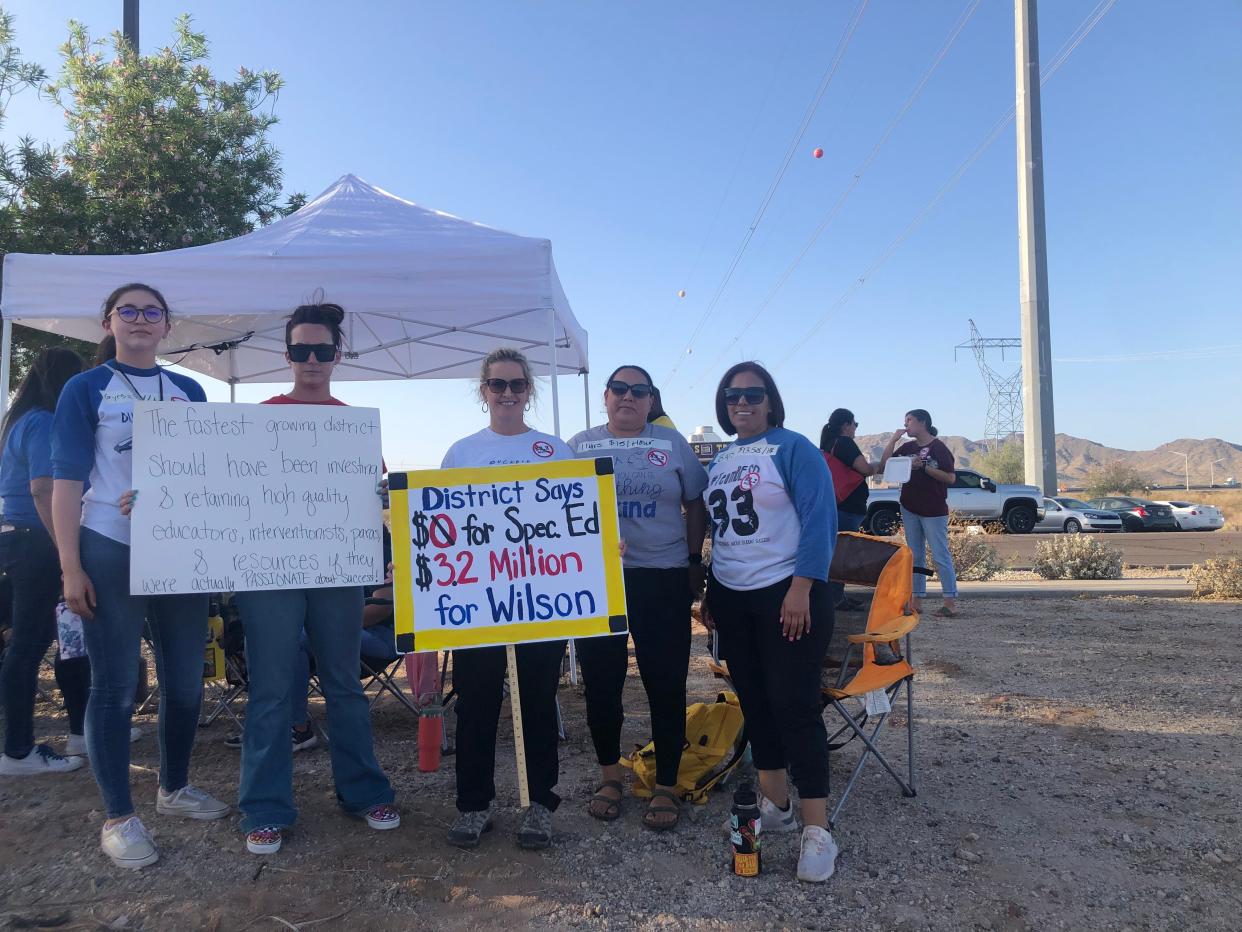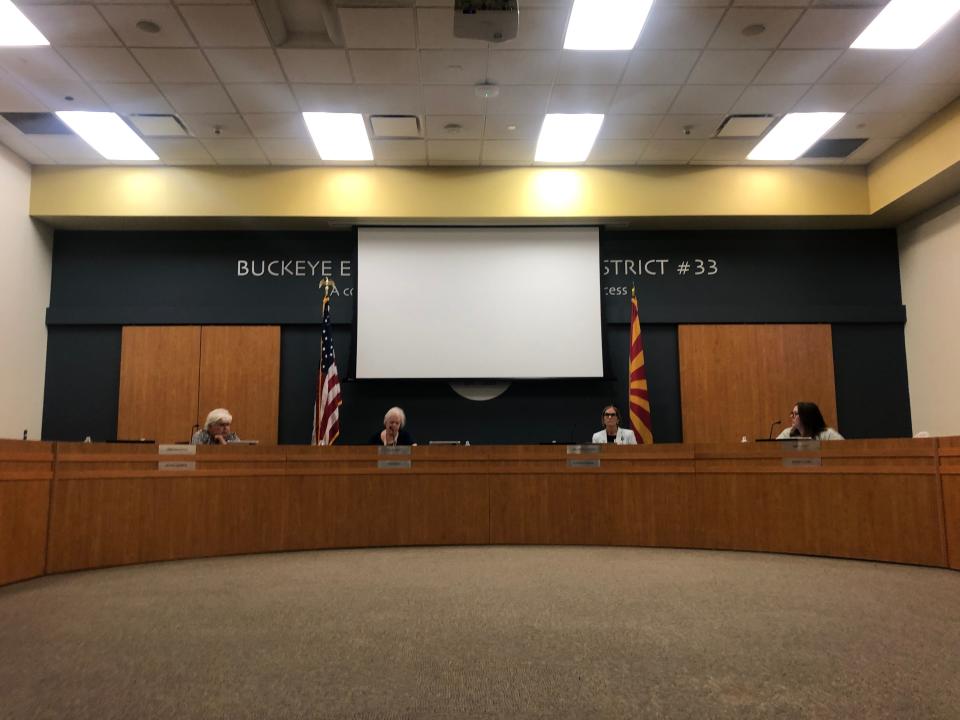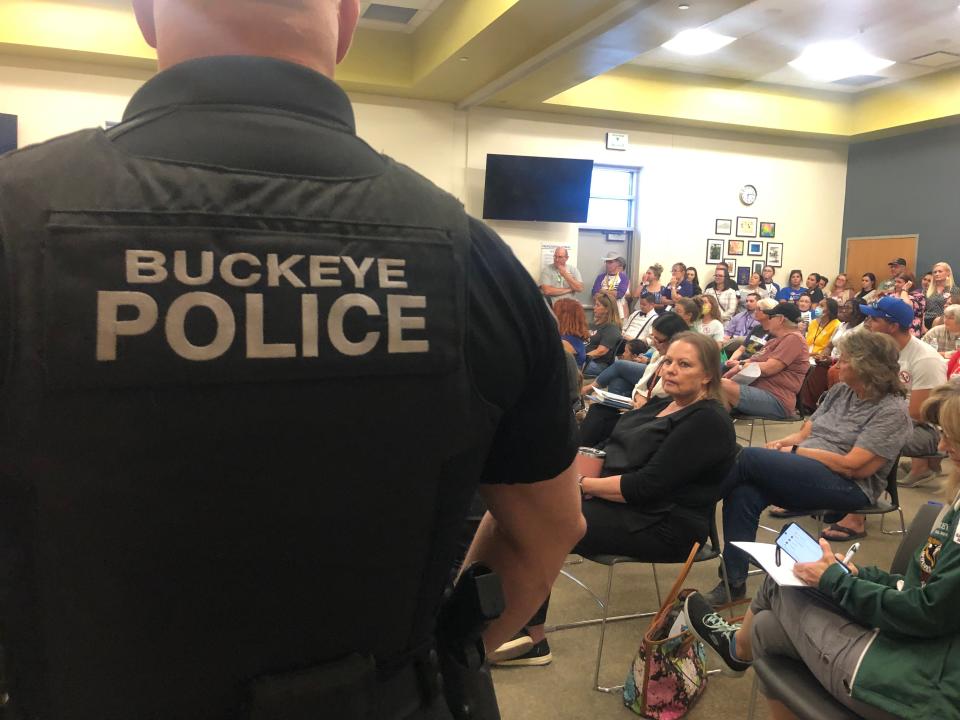Concerns over pay, school funding fuel simmering salary dispute in Buckeye district

When Buckeye Elementary School District occupational therapist Peggy McCahan learned that self-contained special education classrooms at her school were going to lose a paraprofessional due to budget cuts, she was devastated.
She saw every staff member as essential to keeping students, many of whom needed a specialized classroom environment, learning. With one less person, the whole team, including some paraprofessionals who already made $13.25 an hour, would have an even more difficult job.
“These classrooms take a lot more support to educate these students,” said McCahan, who has worked in the district for 13 years and took part in the #RedForEd protests. “The para support in our classrooms is the absolute foundation of our program.”
The discrepancy between the pay of the paraprofessionals in her classroom and the compensation of the district’s superintendent brought McCahan out to a tailgating event sponsored by the Buckeye Education Association and state teachers union on Monday night.
She was joined by dozens of other educators who had gathered before heading into the first Buckeye Elementary School District meeting since the Arizona auditor general’s finding that the district paid its superintendent $1.7 million in retirement credits and unused leave and then failed to note it in public employment records.
While the dispute started in shock about the superintendent’s compensation, teachers' concerns in the weeks since the news dropped are increasingly connected to bigger issues around teacher pay and school funding.
Their call for Buckeye Elementary’s governing board to seek Superintendent Kristi Wilson’s resignation comes almost four years to the day since the Arizona Legislature passed a state budget that included nearly $273 million aimed at giving teachers pay raises after the #RedForEd movement that brought thousands of educators into the street to protest low teacher pay and call for more school funding.
Maria Moreno, president of the Buckeye Education Association and a first grade teacher at WestPark Elementary School, was part of the #RedForEd protests in 2018.
Today, she said she was disappointed as an educator.
“I am embarrassed and disappointed that this board has put the financial wants of the superintendent before students,” Moreno said. “Our class sizes are large, our facilities are lacking. Our classified workers are making a living without making a living wage.”
Teachers, board at odds
As some teachers' anger at the auditor general's revelations has simmered, the Buckeye Elementary board president has continued to support Wilson and the board's compensation package for her.
“Working together, our teachers, staff, administration and parents have done extraordinary things over the past few years. While the COVID-19 pandemic brought progress at some other school districts to a screeching halt, we have forged on as one of Arizona’s fastest-growing school districts,” board president Jane Hunt said in a statement at Monday’s board meeting. “The Buckeye Elementary School District Governing Board stands with Superintendent Dr. Kristi Wilson.”
In a fact sheet shared at Monday's meeting and contesting some of the teachers framing of the discussion, the district said that the average annual compensation for a Buckeye Elementary teacher for next school year would be $56,707 and its teacher compensation package was the highest in the West Valley.
The fact sheet also compared Wilson’s pay with that of leaders of S&P 500 companies, who paid CEO’s more than 100 times more than median employees, while by its estimation Wilson made 3.8 times the amount of an average Buckeye educator.

But educators who took part in an Arizona Education Association-supported action ahead of the meeting and entered the board meeting room together, as well as data from the auditor general, challenged those figures.
The district’s average teacher salary of $44,536 was about 15% below the state average, the auditor general found.
A former employee speaking during the meeting’s public comment also spoke about the district’s teacher pay.
“I am a former employee of the district — I worked in Buckeye from 2013 to 2016,” said Kaitlyn Secor Kutcha, who said she moved to the Agua Fria Union High School District. “I make $20,000 more than I did when I worked here, and I work right up the street. Your best educators are choosing to leave and work elsewhere where they can earn a higher salary.”
Wilson’s recent contract shows her base salary at $189,000, with a possible performance pay bonus that could be up to 20% of each contract current year of her base salary and a $975 per month transportation allowance. In fiscal year 2021, she oversaw 4,937 students at seven schools.
Troy Bales, superintendent of Paradise Valley Unified School District, has an annual salary of $207,000, according to his most recent contract, with an agreement that he could receive up to $10,000 of bonus pay during this contract. He oversees 27,968 students in 42 schools.
Andria "Andi" Fourlis, superintendent of the state’s largest district, the Mesa Unified School District, made a $225,000 base salary for the first year of her current contract, which began in 2020, with a possible 5% increase based on this amount in years two and three. She oversees 55,217 students at 74 schools.
A petition for a vote of no confidence against Wilson, sponsored by the Buckeye Education Association, had 650 signatures as of May 3.

Holli Sierra, a teacher who spoke Monday, contrasted the superintendent’s compensation with the economic situation of students in Buckeye Elementary.
The district students have a poverty rate of 16%, and 66% of students qualify for free or reduced meals. The district’s student population is 63% Latino and 23% white.
“We all know the poverty numbers of our community,” Sierra, who participated in 2018's #RedForEd movement, said. “The board should realize that every dollar we spend above what is morally necessary to supply salaries is a dollar out of the mouths and hands of the students.”
Looking ahead to more growth
The stakes for more funding to go to the classroom, educators say, are particularly high given Buckeye Elementary’s projected growth — and its recent failure to pass its latest override request.
Last fall, the district was one of nine, out of a total of 23 that requested funding, to have its request for a bond or override to voters fail.
Buckeye Elementary asked voters to renew its 10% maintenance and operations override in year four of its seven-year contract, which would have brought in an estimated $3.39 million in the next fiscal year.

The governing board would consider whether to bring the measure to the ballot again, Wilson said in a letter to staff after the vote's failure.
Buckeye has been one of the fastest growing communities in the country over the past few years, showing the largest percentage growth of any city in the country, growing its population by 8.5% between July 1, 2017, and July 1, 2018.
Its school district has seen the impact: Between this school year and last the district student count grew by 8%, with 424 new students coming to district schools. The district opened its newest school, John S. McCain III Elementary, named after the late longtime U.S. senator from Arizona, this school year. The school has 521 students this year.
“We have new families coming here every single day. And failure to do something about the funding in our schools is a failure to fund our teachers more adequately,” Secor Kutcha said. “People aren't going to send their kids here.”
As for the organizing teachers, they say they are not done pushing for change in the district.
Moreno, the first-grade teacher, said the education association would be reaching out to board members one-on-one to understand their role in the compensation issue. And they would consider recruiting candidates for Buckeye's school board that they say would be more supportive of classroom needs.
"When we walked out on our students (in 2018), it was the hardest thing," said Moreno, who protested in 2018 for more classroom funding. "Now, it feels like we are going a little bit backwards."
Reach the reporter at ykunichoff@arizonarepublic.com and follow her on Twitter @yanazure.
Thank you for subscribing. This premium content is made possible because of your connued support of local journalism.
This article originally appeared on Arizona Republic: Concerns over pay, school funding fuel salary dispute in Buckeye

